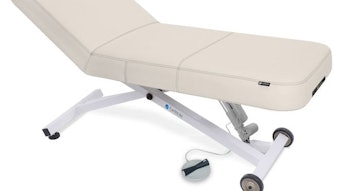
As consumers have become increasingly informed about the skin barrier, they've been able to use this awareness to broaden their approach to skin care; now, finding topicals is no longer about what brands work, but what brands work with their specific skin chemistry. Lifestyle choices like nutrition, emotional health and fitness are now a part of skin consideration. As a culture, we've expanded past the face, taking more care of less prominent parts in the traditional skin care conversation, like our hands, feet and scalps.
Scalp care in particular has flourished due to its skin and hair health implications. However, this can also put skin professionals in a little bit of a tricky spot. While both skin and hair pros play major roles in their clients' scalp care and education, those roles manifest in different ways.
Don't know where to start? No worries, here's the guide to starting with scalp care.
1. Help clients in choosing the right products.
 The current era of products is defined by the emphasis put on clinically-backed results, meaning the necessary rigorous testing to be competitive can make it more difficult for smaller brands to take off.Image by Pixel-Shot / Adobe Stock.
The current era of products is defined by the emphasis put on clinically-backed results, meaning the necessary rigorous testing to be competitive can make it more difficult for smaller brands to take off.Image by Pixel-Shot / Adobe Stock.
When it comes to product education, this can be one of the handiest tools at an esthetician's disposal, although a common pitfall is that it should start at the end, when you're trying to close a sale in retailing.
Product education should start from the moment a client walks in, when you're discussing their goals and performing a skin analysis. Ask them about their scalp and how it feels. Are there any obstacles they're encountering? Too oily? Too dry? Dandruff?
If you're performing a scalp treatment, you can take this time to educate them on any products you're using and what makes them effective. If it's a brand that's available for them to purchase after, be sure to mention this as well. If not, though, educating them on the ingredients they should keep an eye out for, like aloe, biotin and licorice root, can go a long way.
Meanwhile, brands like Antidotpro have scalp and hair products, and while you'll be focused on the scalp products, building out a network of hair professionals who also use Antidotpro can be a valuable way to encourage cohesion in your client's overall beauty and wellness plan.
2. Brush up on your technique.
 The regulatory scramble that happens with the rise of new treatments means that new arrivals often face a lengthy and resource-intensive process before becoming commonplace.Image by kei907 / Adobe Stock.
The regulatory scramble that happens with the rise of new treatments means that new arrivals often face a lengthy and resource-intensive process before becoming commonplace.Image by kei907 / Adobe Stock.
If applying a scalp mask or performing a treatment, ensure you've learned and practiced the art of the scalp massage. Also, it's important to understand where the line is. While massage therapists and estheticians can perform scalp massages and apply masks, shampooing, blow drying and the use of hot tools is not covered by those same licenses, so be sure to check your state's regulations to be certain of what you're able to do.
Take courses specializing in scalp care to get certifications and to become more familiar with the benefits and brands operating in the realm of scalp care. Make sure you take stock of what you can logistically stand to incorporate in terms of scalp care, and how incorporating scalp treatments may impact your appointment times, if at all.
3. Have a network of other professionals.
 Skin and hair pros can benefit in having a doctor in their network, so they can refer clients to a trusted resource and work synergistically.Image by Lena May / Adobe Stock.
Skin and hair pros can benefit in having a doctor in their network, so they can refer clients to a trusted resource and work synergistically.Image by Lena May / Adobe Stock.
We've mentioned this a little already re: hair professionals, but don't forget that sometimes a stubborn scalp is more than just being too dry or too oily. If you think your client may have a medical condition, refer them to a dermatologist. Having a dermatologist in your network is a good idea anyway, for other non-scalp related skin conditions a client might have, for trusted referrals and again, more cohesion in your client's skin journey.
4. Think about what you want your scalp add-ons to look like.
 The trend in holistic wellness means that many spas are incorporating CBD-infused treatments, meditation and sleep ritual therapy as add-ons.Image by Pixel-Shot / Adobe Stock.
The trend in holistic wellness means that many spas are incorporating CBD-infused treatments, meditation and sleep ritual therapy as add-ons.Image by Pixel-Shot / Adobe Stock.
Take your current clientele into account. Are you planning for the dry, winter months? Consider utilizing hydrating masks and serums. Do you have a lot of male clients? Consider treatments meant to stimulate blood flow and hair growth.
If you're at a loss of what your clients need, just ask! Consider leaving room for goals or skin and scalp concerns on your booking pages.
5. Make sure you have the right tools.
 Be sure to check local regulations to see what tools and devices you can use!Image by triocean / Adobe Stock.
Be sure to check local regulations to see what tools and devices you can use!Image by triocean / Adobe Stock.
Again, after checking your local regulations, consider the tools that can enhance the way you offer scalp services and how they fit into your budget. Tools like a scalp analysis scope, exfoliation and massage tools and steamers may all be valuable additions, depending on the type of scalp treatments you offer and your clients' needs.










